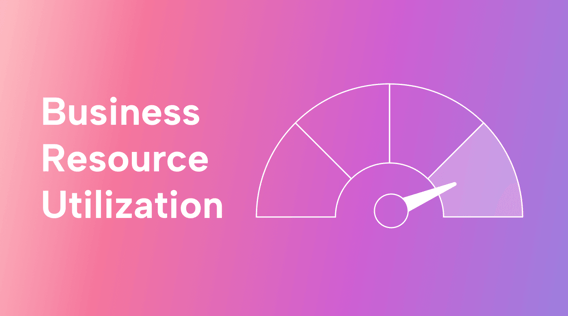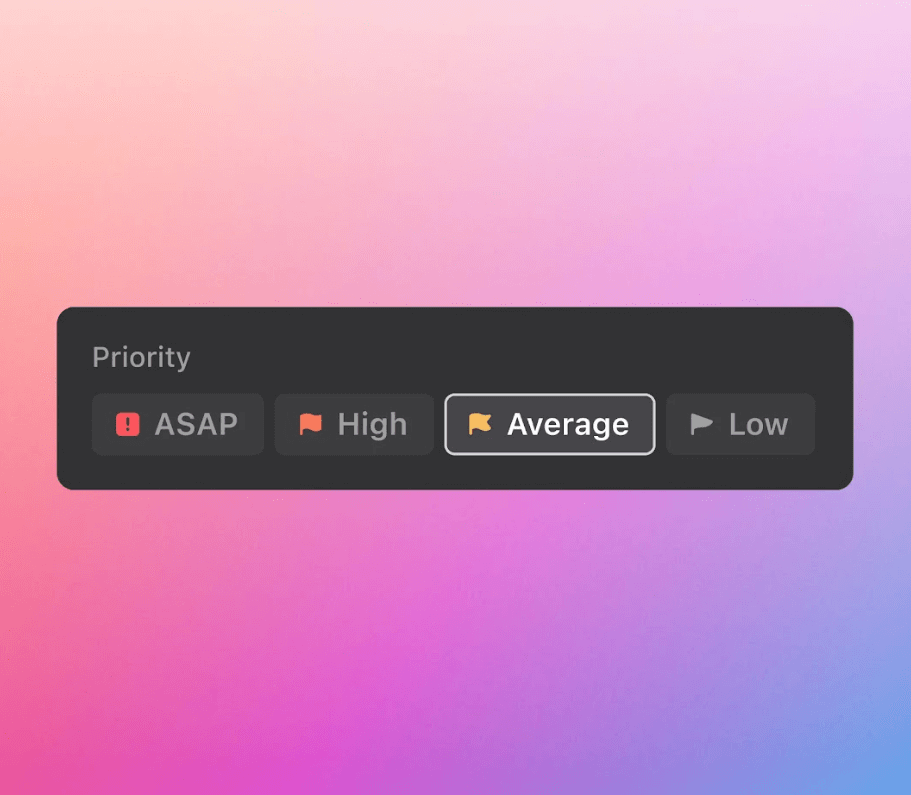Overworked staff, low-profit margins, and more client requests than you can handle. Managing resources is one of the most challenging parts of running a business.
In fact, according to the Harvard Business Review, only 35% of projects are completed successfully. When you consider the costs of hiring and managing staff in this economy, poor project outcomes could mean thousands of dollars in lost profit for your business.
Effective resource utilization drives sustainable growth in business. It does this by giving you a way to measure where your staff spends their time. It also helps you bill your clients more accurately for this time.
In this article, we’ll walk you through everything you need to know about resource utilization. Help your business be more efficient and enjoy sustainable growth.
What is resource utilization?
Resource utilization refers to the use of available resources in your business. These resources can include your staff, equipment, materials, and technology. How well you use your resources is critical to maximizing productivity while minimizing waste.
What is resource utilization vs. resource allocation?
Though these terms sound similar, they aren’t the same thing. Actually, these are two processes that work together.
Resource utilization refers to how much of your resources you use in completing tasks or projects. It focuses on how well resources are used to achieve desired outcomes. For example, how many hours did your copywriter need to complete a client project like writing a blog post? It involves monitoring and measuring your resources to decide if they are being used efficiently.
Resource allocation is the process of assigning or distributing resources to different tasks, projects, or departments within your business. It involves determining the appropriate allocation of resources based on priorities, needs, and availability. Resource allocation ensures that resources are assigned to the right areas or projects at the right time.
For example: If you have too many client projects outstanding, it wouldn’t make sense to allocate your best copywriter to an internal marketing project.
Resource allocation and utilization serve different functions, but both are essential in optimizing resource management.
Overutilization vs. underutilization: what’s the difference?
There are two terms to consider when it comes to how well you are using your resources in your business: overutilization and underutilization. These terms help you to understand the resource availability in your business and their utilization in project management.
Overutilization:
When resources are overused or strained beyond their capacity, you can face a whole range of issues. Inefficiencies, burnout, and potential quality issues are just some of the problems overutilization causes.
For example, if you have more copywriting tasks for your writers than they can manage in a day, they have to work nights and weekends to keep up. This is overutilization and can lead to employee dissatisfaction, low morale, and roadblocks in your project management.
Underutilization:
Sometimes, you might find that you have the opposite issues. Your team seems to be sitting around more, not scheduled or simply idle. This results in wasted potential, decreased productivity, and missed opportunities for growth. Not to mention the fact that you’re paying for staff that are sitting around.
No one wants to be bored, and you don’t want to pay someone to waste company time. This is a pretty obvious example, but underutilization can also be much more subtle.
For example: Imagine your social media managers have automated posting on your social media channels. A software program now manages a task that once took them hours every week. If this time isn’t now assigned to other tasks, your social media team is underutilized. While you might think, “It can’t be that much time,” 4 hours a week over a year adds up, especially with the current labor cost.
Why is resource utilization important for your business?
Before we look at these calculations, let’s examine the benefits of resource utilization for your business.
Resource utilization offers so many advantages to keep your business growth steady and sustainable, such as:
Enhancing your overall productivity
Getting a better handle on your resource management helps you work smarter, not harder. It means getting more done with the resources you already have.
Maximizing how you use your resources can achieve better results without needing extra staff or equipment. Meeting deadlines becomes easier, and you can allocate resources to important internal projects. Your business runs more smoothly, and projects are delivered more successfully.
When you see where resources are underused, you can redirect them to strategic revenue-generating activities, like marketing or sales training. Increase your revenue by attracting new clients and improving your sales conversion rates without spending any additional money. Efficient resource use is the key to long-term success.
Reducing waste
Cut down on waste by using all available tools, time, and skills. Avoid overloading your team, and prevent unnecessary waiting, idleness, and inefficiencies. This means tasks get done faster, there’s less unused capacity, and you save money by not wasting what you have. Think of your resources like those staples in your pantry. They will end up in the trash bin if you’re not cooking them.
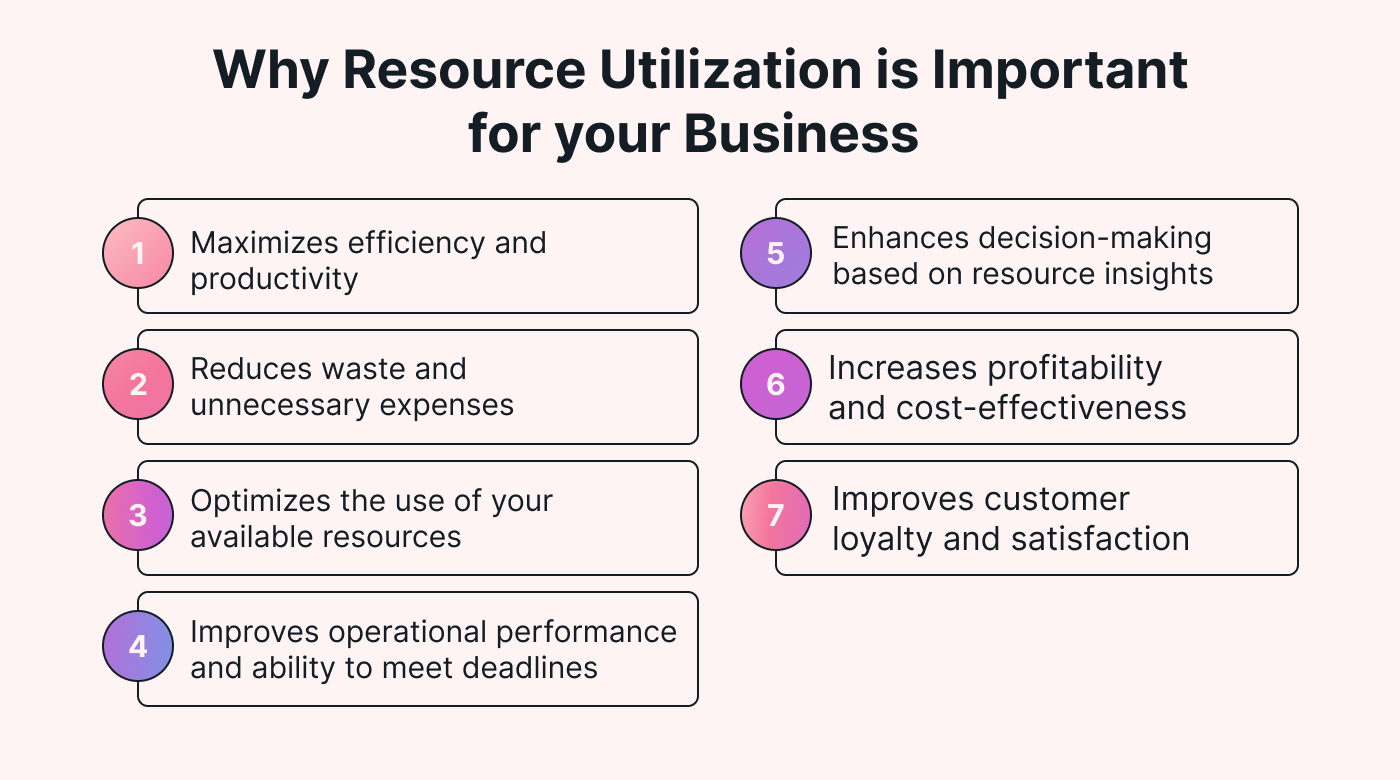 |
When you optimize how you use your resources, you’ll find a balance where you get the most out of what you have without overburdening yourself or your team.
Improving time management
When it comes to managing your time and getting things done, resource utilization means you’ll have the right people and materials available when needed. This way, your team can get started on billable tasks immediately, and you’re not wasting precious minutes waiting around.
Plus, future projects will get done faster. You can allocate the right things to each task, making everything run smoothly. That means you can finish projects sooner and move on to the next exciting thing.
Your deadlines become realistic, too. When you plan your projects with your resources in mind, you can set achievable goals from the start.
Gaining a competitive advantage
Gain a competitive edge by being able to deliver projects more effectively. As you build a reputation for providing quality work on time and budget, you’ll earn the trust of your customers. This improves loyalty and customer satisfaction.
Making your business more flexible and adaptable
Make your business more adaptable to changing market conditions. During times like the pandemic, having a profit buffer allowed some agencies to shift their operations online. Effective employees could remain productive while working from home, and being digital-only meant that information systems were ready for teams.
A 2022 project management study by KPMG found that 33% of respondents listed change management as an essential skill required by businesses. When you have your resources under control, and they trust you, you can handle any planned or unexpected changes that may arise.
And that's not all! Having a buffer in resource utilization opens up opportunities for your business. For example, let's say there's a last-minute end-of-fiscal-year sale. With available resources, like a ready marketing team, you can jump on this opportunity and increase revenue. Plus, offering great service during the sale can lead to repeat business and ongoing revenue growth.
Ensuring long-term growth
Boosting your business’s profitability is essential to being a business owner. Effective resource planning can play a significant role. You can keep your profitability high by factoring in your profit margins before taking on new projects. This means being mindful of costs and ensuring you get the most value for your investments.
Another advantage is that you can recognize growth opportunities when you manage your resources well. With fewer distractions, you can focus on upselling existing clients, pursuing new projects, and offering additional services to increase revenue.
By improving resource utilization and allocation, you can create a more sustainable business model with reliable profit margins and opportunities to increase revenue and customer satisfaction.
Common calculations for resource utilization
When it comes to common calculations for resources, we’ll focus on three areas:
- Resource utilization
- Realization rate
- Ideal billing rate.
Your resource managers (or project managers) must understand these formulas to give you utilization rates you can trust, especially when evaluating past billable projects and better scoping future client projects.
Scoping projects becomes more manageable when you understand billable time, resource capacity, and optimal resource utilization.
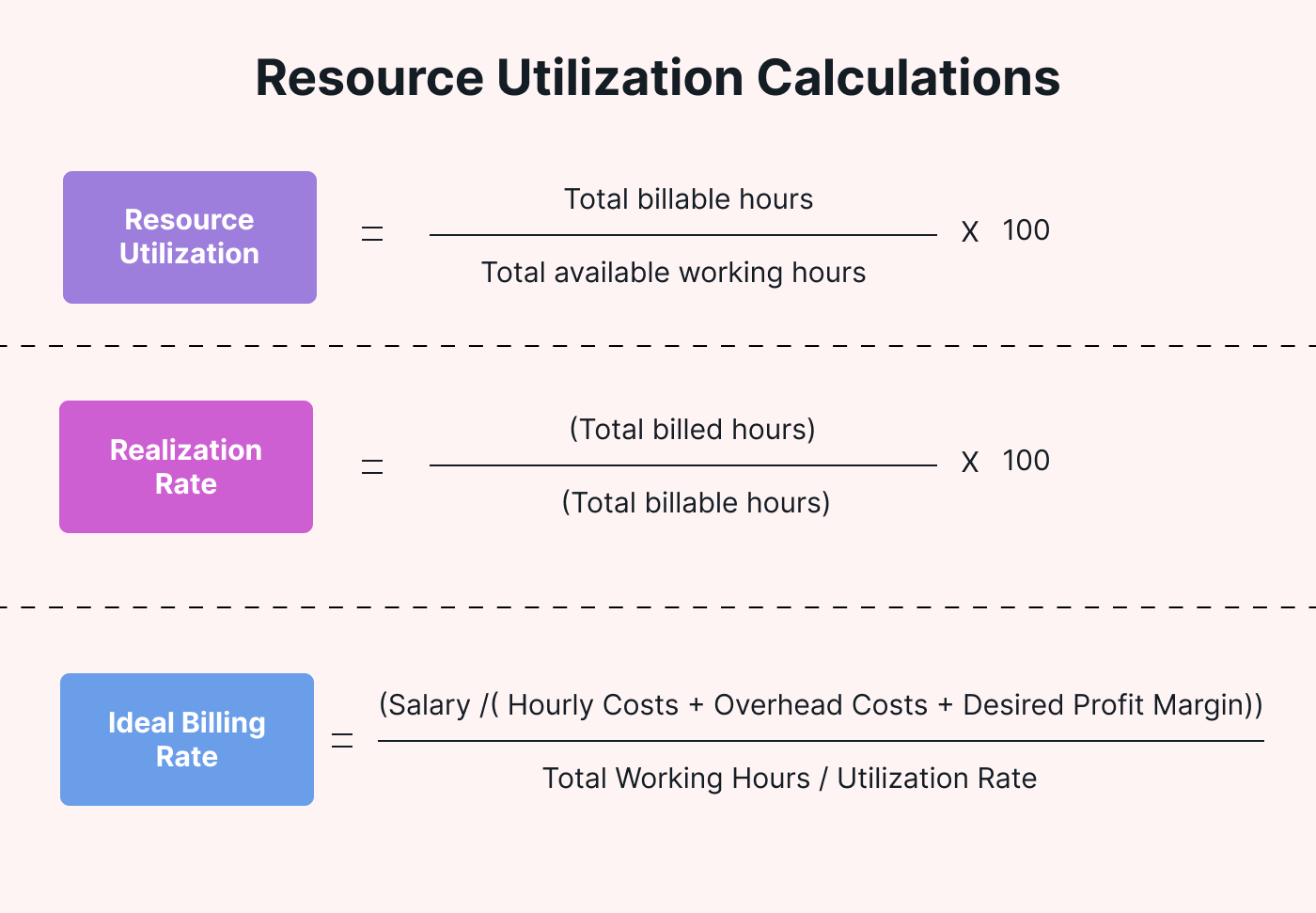 |
How to calculate your resource utilization rate
To understand how over or underutilized your resources are, divide total billable hours by total available working hours. Then, you multiply the value by 100 to get a percentage.
Resource utilization = Total billable hours / Total available working hours x 100
Here’s an example:
Angela Smith (Copywriter) = 36 billable hours / 40 available working hours x 100 = 90% utilization
How to calculate your realization rate
To assess your project revenue efficiency, divide your total billed hours by your total billable hours. Then, multiply this by 100 to get a percentage.
Realization rate = (total Billed Hours) / (Total Billable Hours) x 100
Here’s an example: Of 40 hours worked, 36 were billable hours. Of the 36, 34 were billed to the customer resulting in project revenue.
Angela (Copywriter) = 34 Billed Hours / 36 Billable Hours * 100 = 94.44% Realized.
How to calculate your ideal billing rate
One of the best parts of getting a deeper understanding of your resources is learning how to increase your profit. Do this by calculating your ideal billing rate. Let’s take a look:
Ideal billing rate = (Salary /( hourly costs + overhead costs + desired profit margin)) ÷ total working hours ÷ utilization rate
For example: Angela’s salary is $90,000. There are $7,000 in overhead costs per employee. The target profit margin is 20%.
Salary = $90,000
Overhead Costs Per Employee = $7,000
Target Profit Margin = 20%
Note: Be sure to adjust your numerator. For example, the sum ($116,400) must be divided by the total average labor hours (1,100).
If the total labor hours are 1,100, then the numerator equals 144
[$90,000 + $7,000 + (20% × $90,000)] ÷ 1,100 = 106
Then, assuming a capacity utilization of 94.44%, the optimal billing rate comes out to $112.28 per hour.
The optimal billing rate for Angela = 106 ÷ 94.4% = $112.28
As long as you are billing clients a little over $110/hour for Angela’s time, you can comfortably schedule her at a 94.4% utilization rate while keeping your desired profit margin.
Motion and resource utilization
Once you've calculated your current rates and have your ideal billable rate ready to go, take advantage of AI-driven tools in Motion. Create your own simple version of resource management software.
Manage your projects
Create projects and define specific billable tasks or milestones for each project. Assign your people and then watch as Motion auto-schedules the tasks, and delivers work time to the team members responsible for completing them.
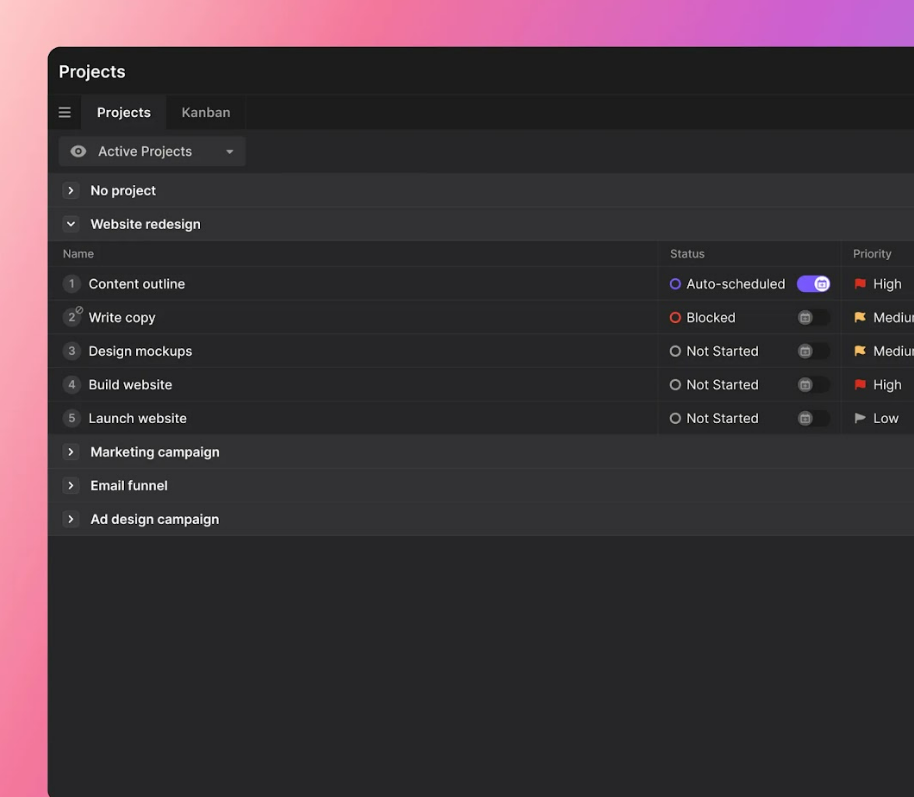 |
Integrate your teams’ calendars to automate staff resource scheduling. Keep an eye on your staff resource capacity and make sure they’re not too busy. In fact, Motion will let you know if that’s the case.
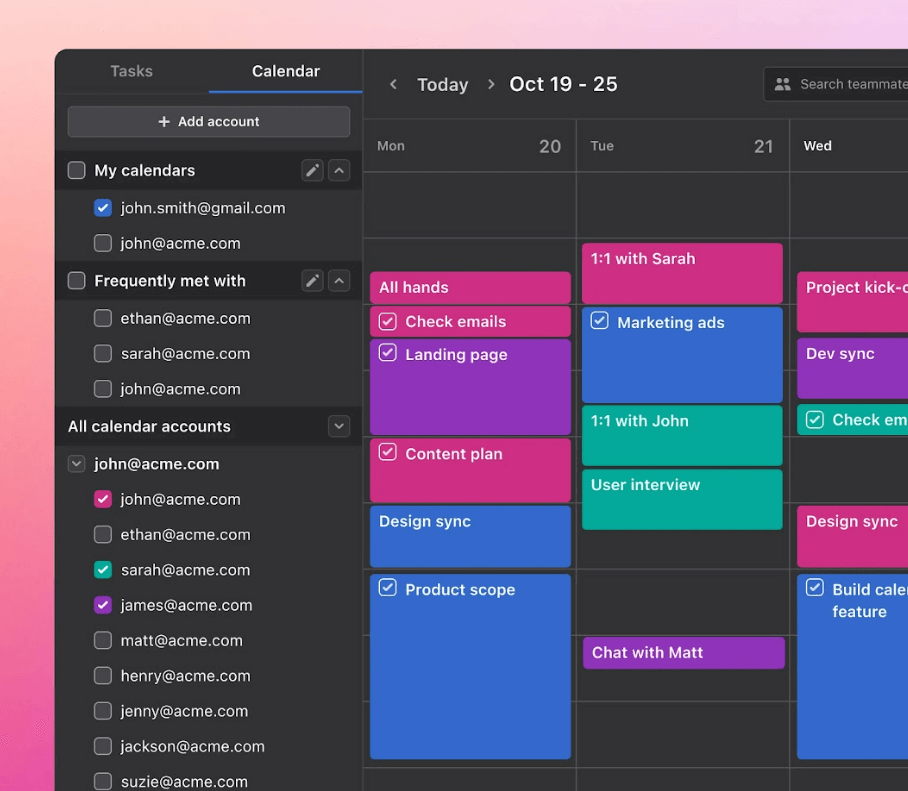 |
Allocate resources more effectively
Motion is excellent at knowing when time is available to schedule something for you. It does so considering priorities, deadlines and estimated duration for tasks. When you assign tasks to your team, Motion will consider their workload and adjust their daily schedule. This makes your team more productive. Plus, you can trust that tasks will get done on time.
Monitor progress
Regularly review project progress in Motion. Monitor how much time is being allocated to each task and project. Identify potential bottlenecks or areas needing improvement. Turn on resource alerts to get notified when your team members are overloaded so you can make adjustments.
Adjust and optimize
Based on the data and insights from Motion, make necessary adjustments to resource allocation. Update task priorities. Even change project timelines. Optimize your workflows to improve efficiency by using Motion’s intelligent task auto-scheduler.
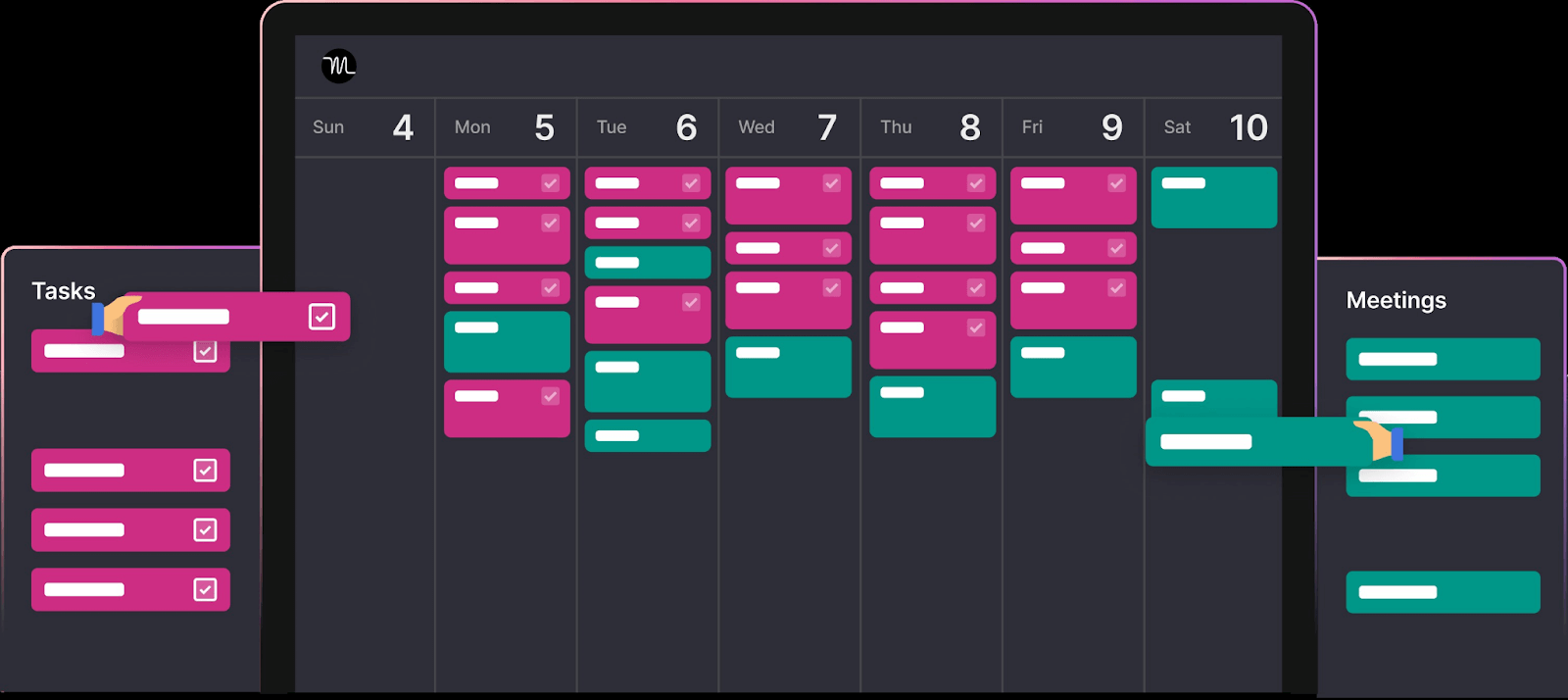 |
Collaboration and communication
Motion allows for easy communication for your team members. Encourage team members to provide updates and communicate their progress. Have them raise any concerns or challenges they face on the task cards.
Use Motion's AI-driven project management features to access better visibility into how you are allocating resources. Improve your project management and team productivity all at once.
What’s next for your resource management?
We know how challenging managing multiple projects for your own business is. Not to mention when you’re also juggling projects for your customers. But, with better resource management, you have everything you need to understand how you use your resources to create a foundation for long-term business growth.
So what’s next for your business when managing your resources?
Why not automate your project management and take advantage of better oversight of your resources? Try Motion today.

